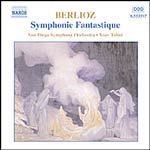
Berlioz: Symphonie Fantastique
 $25.00
Low Stock
add to cart
$25.00
Low Stock
add to cart
HECTOR BERLIOZ
Berlioz: Symphonie Fantastique
San Diego Symphony Orchestra, Yoav Talmi
[ Naxos / CD ]
Release Date: Sunday 3 February 2002
Should this item be out of stock at the time of your order, we would expect to be able to supply it to you within 2 - 5 business days.
"This account has plenty of fire and imagination" (ClassicsToday)
"Talmi's account offers plenty of interest in any case, even if you're already steeped in performances of the work. This account has plenty of fire and imagination at its best, and at the price it's certainly worth a listen."
- Michael Jameson, ClassicsToday.com, January 25, 2002
Hector Berlioz was born in the French province of Isère in 1803, the son of a doctor. He abandoned his own medical studies, on which his father had insisted, to become a musician, but was to remain an outsider as far as the musical establishment in Paris was concerned, his music seeming at times extravagantly bizarre, his character, to say the least, difficult, and his literary activities, as a music critic, controversial.
It was in 1824 that Berlioz finally gave up medicine. His first visit to the dissecting-room, decribed in lurid terms in his Memoirs, provided an initial and startling disincentive, as he saw birds fighting for scraps of human lungs and rats in the corner of the room, gnawing vertebrae. At the same time Paris offered musical opportunities. There was the Opéra, and the Conservatoire Library was open to the public. He was able to profit, too, by lessons from Lesueur, whose class he was later to enter at the Conservatoire, where he became a student in 1826.
The following year Berlioz saw Shakespeare's Hamlet for the first time, with Charles Kemble as the Prince and the Irish actress Harriet Smithson as Ophelia. The experience was overwhelming, accentuated by the performance of Romeo and Juliet that he saw a few days later. During the season he had the opportunity to see much more of the visiting English company sharing in the popular adulation of Harriet Smithson, with whom he fell violently in love.
The Symphonie fantastique was written in reaction to the intense and unreciprocated passion Berlioz felt for Harriet Smithson, and with something of the resentment he felt, possibly augmented by his brief association with Camille Moke, who was to marry the piano manufacturer Pleyel. In the end Berlioz was to marry his Ophelia, a match that brought neither of them any lasting satisfaction, as her own career waned into querulous drunkenness and his musical and extra-marital amatory preoccupations assumed greater importance.
The Symphonie fantastique is a remarkable work, autobiographical in content and immensely influential in the path it suggested to future composers, anxious to extend the scope of musical expression in the generation after Beethoven. Described as An Episode in the Life of an Artist, the symphony is haunted by an idée fixe, a recurrent fragment of melody, symbolizing the beloved, a prototype of the Leitmotiv, to be developed by Wagner. In 1830 the autobiographical nature of the symphony represented something entirely new.
A young musician, in despair, has poisoned himself with opium and in a long sleep has a series of vivid dreams and nightmares, the idea of his beloved coming again and again to his mind. He recalls the joys and depressions of the past, before she came into his life, and then the neurotic despair and jealousy that her appearance brought him, with passing consolation in religious serenity. The second movement evokes the music of a ball, at which, in the swirl of the dance, he catches glimpses of his beloved again. This is followed by a third movement that cost the composer much labour. In the countryside two shepherd boys play a melody to call the cows, and all is tranquillity until the beloved appears again, with all the anxious questioning that that must provoke. A shepherd plays his pipe, but this time there is no answer, and as the sun sets distant thunder is heard, followed by silence. The March to the Scaffold, written in one night, brings a dream of the murder of the beloved, for which the hero is condemned to death. The march, with its steady tread, has its wilder moments, as the procession makes its way through the crowd. The beloved appears at the moment before the axe falls. The final movement is a Witches' Sabbath, a wild orgy of diabolic celebration, the idèe fixe of the beloved now a shrill mockery. The death knell is heard and the sound of the traditional chant of the Dies irae, the hymn of the Day of Judgement from the Requiem Mass, mingles with the dance, as the work draws to an end.

